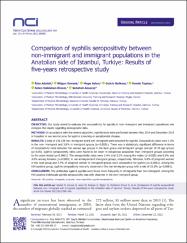| dc.contributor.author | Adaleti, Rıza | |
| dc.contributor.author | Kansak, Nilgün | |
| dc.contributor.author | Aslan, Müge | |
| dc.contributor.author | Balköse, Gülçin | |
| dc.contributor.author | Toptan, Hande | |
| dc.contributor.author | Daldaban Dinçer, Şölen | |
| dc.contributor.author | Aksaray, Sebahat | |
| dc.date.accessioned | 2023-01-26T11:11:03Z | |
| dc.date.available | 2023-01-26T11:11:03Z | |
| dc.date.issued | 2022 | en_US |
| dc.identifier.citation | Adaleti R, Kansak N, Aslan M, Balkose G, Toptan H, Dincer SD, Aksaray S. Comparison of syphilis seropositivity between non-immigrant and immigrant populations in the Anatolian side of Istanbul, Turkiye: Results of five-years retrospective study. North Clin Istanb. 2022 Dec 22;9(6):590-594. doi: 10.14744/nci.2021.80688. PMID: 36685633; PMCID: PMC9833385. | en_US |
| dc.identifier.uri | https://www.ncbi.nlm.nih.gov/pmc/articles/PMC9833385/pdf/NCI-9-590.pdf | |
| dc.identifier.uri | https://hdl.handle.net/20.500.12809/10500 | |
| dc.description.abstract | Objective: Our study aimed to evaluate the seropositivity for syphilis in non- immigrant and immigrant populations and compare the results regarding demographic data.
Methods: In accordance with the reverse algorithm, syphilis tests were performed between May 2014 and December 2018 in hospitals in our service zone for syphilis screening or symptomatic disease.
Results: A total of 135.328 non- immigrant and 6.641 immigrant were screened for syphilis. Seropositivity rates were 1.3% in the non- immigrant and 3.8% in immigrant groups (p=0.0001). There was a statistically significant difference in terms of seropositivity rates between the various age groups in the local group and immigrant groups (except 18 25 age group) (p<0.05). Syphilis seropositivity rates were found to be lower in indigenous population than immigrant groups according to the years tested (p=0.0001). The seropositivity rates were 2.4% and 3.2% among the males (p=0.025) and 0.6% and 4.0% among females (p=0.0001) in non-immigrantand immigrant groups, respectively. Whereas, 0.6% of pregnant women in the local group and 3.7% of pregnant women in immigrant groups were seropositive for syphilis (p=0.0001). Among the HIV positive group, syphilis seropositivity was only observed in the non-immigrant group with a rate of 23.0% (p=0.0001).
Conclusion: The antibodies against syphilis were found more frequently in immigrants than non-immigrant. Among the HIV positive individuals syphilis seropositivity was only observed in the non-immigrant group. | en_US |
| dc.item-language.iso | eng | en_US |
| dc.publisher | Health Directorate of Istanbul | en_US |
| dc.relation.isversionof | 10.14744/nci.2021.80688 | en_US |
| dc.item-rights | info:eu-repo/semantics/openAccess | en_US |
| dc.subject | HIV positive | en_US |
| dc.subject | Immigrant | en_US |
| dc.subject | Pregnant | en_US |
| dc.subject | Revers algorithm | en_US |
| dc.subject | Syphilis seropositivity | en_US |
| dc.title | Comparison of syphilis seropositivity between non-immigrant and immigrant populations in the Anatolian side of Istanbul, Turkiye: Results of five-years retrospective study | en_US |
| dc.item-type | article | en_US |
| dc.contributor.department | MÜ, Tıp Fakültesi, Eğitim ve Araştırma Hastanesiü | en_US |
| dc.contributor.authorID | 0000-0002-0129-4464 | en_US |
| dc.contributor.institutionauthor | Baköse, Gülçin | |
| dc.identifier.volume | 9 | en_US |
| dc.identifier.issue | 6 | en_US |
| dc.identifier.startpage | 590 | en_US |
| dc.identifier.endpage | 594 | en_US |
| dc.relation.journal | Northern Clinics of Istanbul | en_US |
| dc.relation.publicationcategory | Makale - Uluslararası Hakemli Dergi - Kurum Öğretim Elemanı | en_US |


















